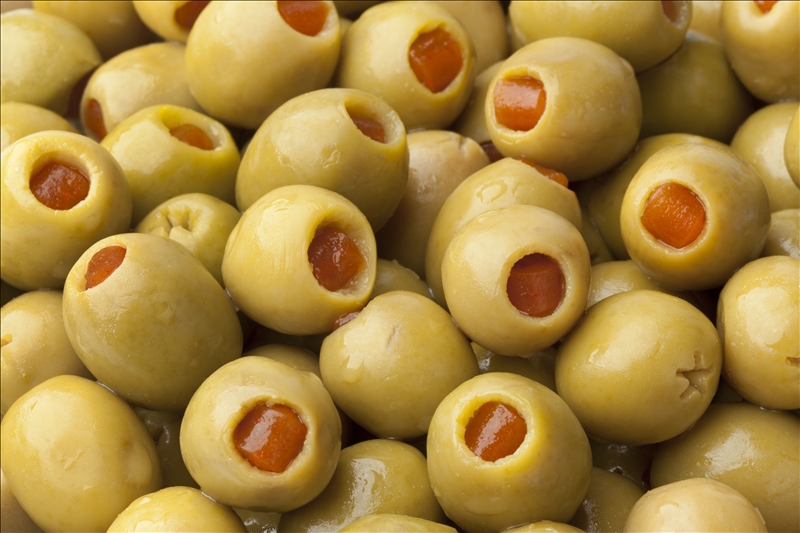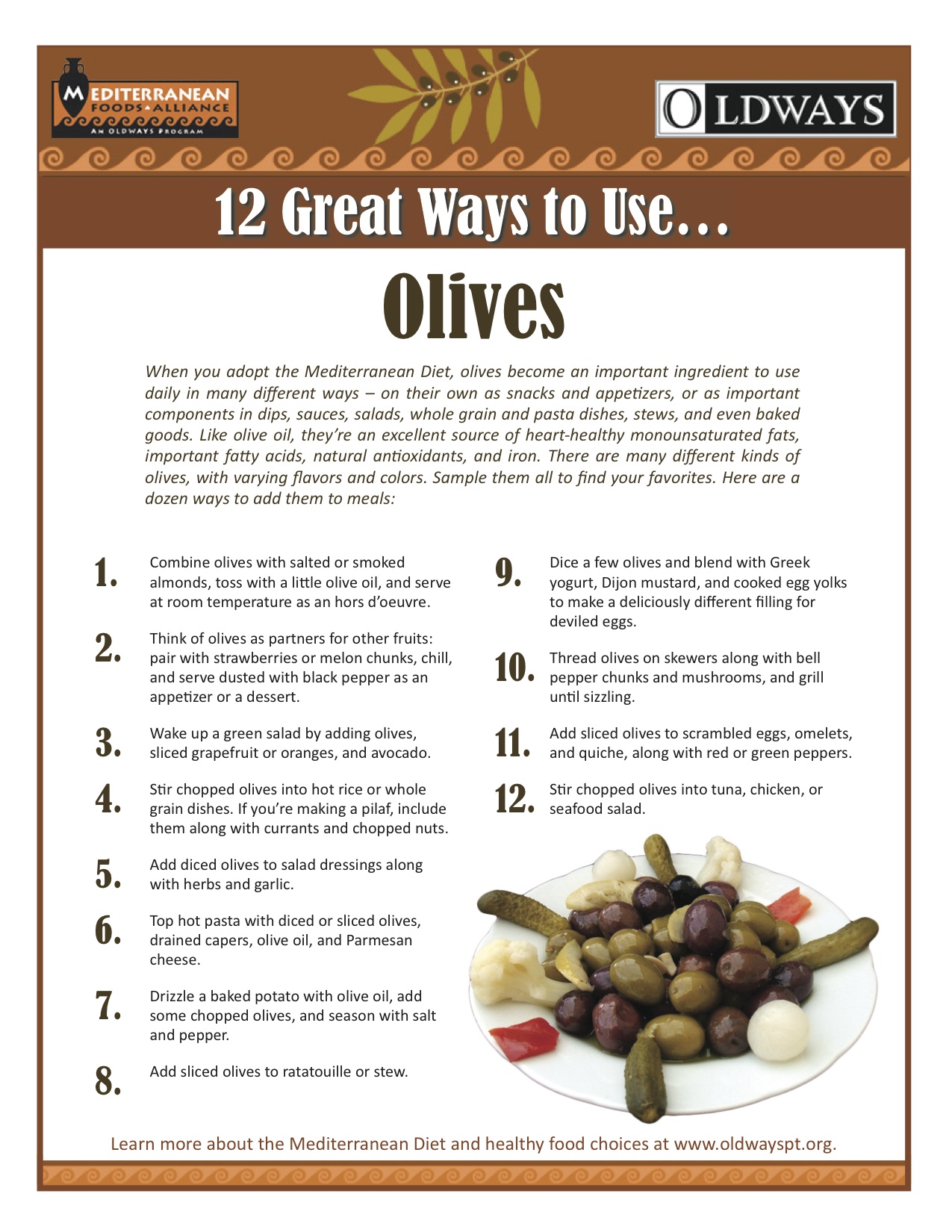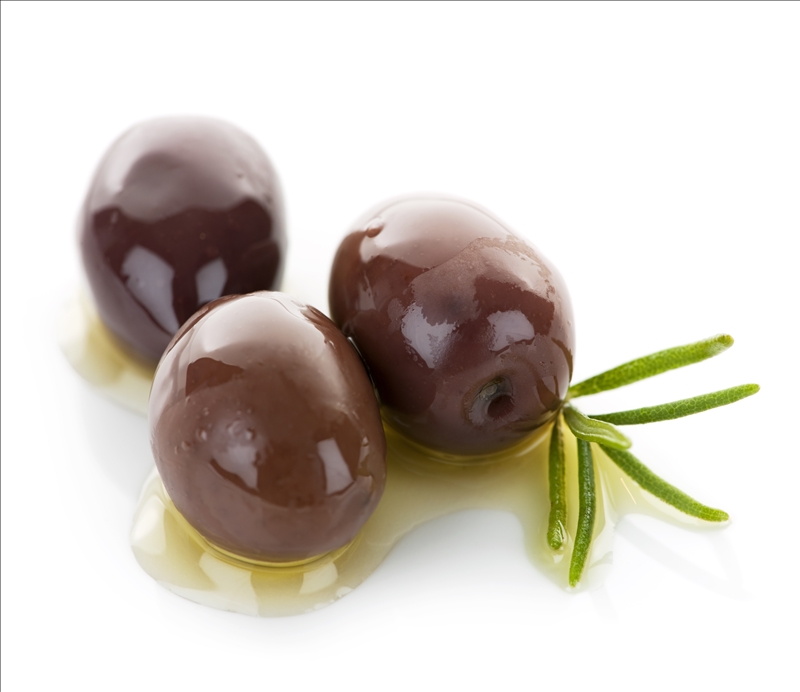
Little green olives stuffed with pimento. Growing up, that’s the only olive I ever knew. Years later I had the good fortune to travel throughout Greece, beginning with a stop in Corfu. My friends and I toured the island on rented motorbikes and stopped at a hillside café — really just someone’s backyard. We were served a plate filled with chunks of cucumber and different kinds of olives. They were definitely not my mother’s olives — not to mention that they were accompanied by glasses of ouzo!
Did you know there are hundreds of varieties of olives? They grow on trees — trees that can live thousands of years — and are native to the Mediterranean, Asia and Africa. They thrive on the hillsides of Spain, Italy and Greece. About five varieties are grown in the United States, most commercially. Olives are a staple in the Mediterranean diet, which research shows is a healthy way to eat.
“I tend to think of olives as mostly a garnish of sorts, not really a food, but in the Mediterranean diet they are indeed a food, says Kitty Broihier, a registered dietitian and member of the Maine Academy of Nutrition and Dietetics. “Olives are rich in phytonutrients that exhibit anti-inflammatory and antioxidant effects.”
Green versus black
Green olives are picked before they’re ripe and black olives, after. Generally, the darker the olive the riper it is. A so-called black olive can range from a light brown to red and purple to deep black.
Why olives are cured
No matter what color or how ripe, olives are usually too bitter to eat straight from the tree and need to be cured first.
Curing with water or brine
The more traditional way of curing olives is to submerge them in vats of fresh water or seasoned and salted brine, which brings out the natural flavors.
Curing with dry salt
Raw olives are rubbed with salt and left to cure for weeks or months. When the salt is removed, the olives are coated with olive oil so they won’t get too dry, but they tend to look wrinkled. Dry-cured olives tend to have intense flavors.
Curing with lye
Lye is a processing agent in some olives, particularly the Spanish Manzanilla and Queen olives. When olives are brought in fresh they are treated with a solution of lye and fresh water in order to de-bitter the olives more rapidly. The olives are then washed completely before they begin the curing process in a natural brine. Because the olives have been washed, the lye does not need to be listed as an ingredient. Typical black ripe olives you find in the supermarket, as well as some other varieties, are not cured (fermented) at all and have actually been lye-processed to remove bitterness.
Watch the salt!
“If you’re one of those folks who needs to watch sodium, you may want to go the olive oil route instead of the olive route when following a Mediterranean eating plan,” cautions Kitty.
The truth about Kalamata olives
When I originally published this post about olives, I stated that a Kalamata olive must be grown in Kalamata to be called a Kalamata. I was told that by more than one “olive expert.” But Anthony DiPietro says I was duped. His family owns DeLallo, a PA company that has been curing and importing olives for 65 years. Here’s what Anthony says is the real story:
“Although for some time the area of Kalamata in the region of Messina has been trying to lobby to protect their fruit to be only allowed to be called “Kalamata” or “Calamata” it is not true either in the EU or here that only fruit of that variety specifically from there can be called Calamata. First, it would not be practical because they are only a small portion of the annual crop. Second, although the olives may have grown there for centuries, they have thrived throughout the regions of the Peloponnese Peninsula as well as Western & Central Greece, with each region having typical size ranges and aspects to their yields of this variety. Finally, although common, curing in red wine vinegar is not authentic or traditional. The typical curing process is a standard brine solution. Red wine vinegar is often added to mask both color and flavor of fruit selected un-ripened. Calamata olives get their typical “winey” flavor from natural lactobacillus yeast on their skin that continue to grow throughout curing so if fruit is harvested at the correct ripeness and cured correctly is not needed.”
12 great ways to use olives
These serving tips come from Oldways, an organization that “raises awareness of Mediterranean foods and flavors and the remarkably healthy Med Diet lifestyle.”
 How to pit an olive (by hand)
How to pit an olive (by hand)
Step 1: Put the olive on a cutting board and firmly press down on it with the side of a large chef’s knife. You should feel the pit begin to pop out. If not, use the knife to apply a gentle rocking motion and roll the olive back and forth a few times.
Step 2: When the olive splits open, pull out the pit.
Fruit or vegetable?
Technically olives are a fruit, but in the culinary world, are usually treated as a vegetable. How do you like your olives?


Leave A Comment